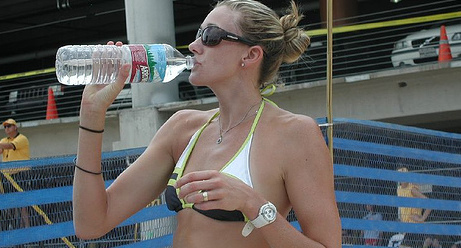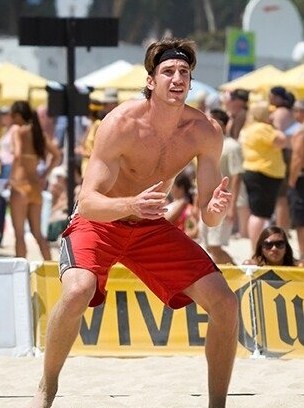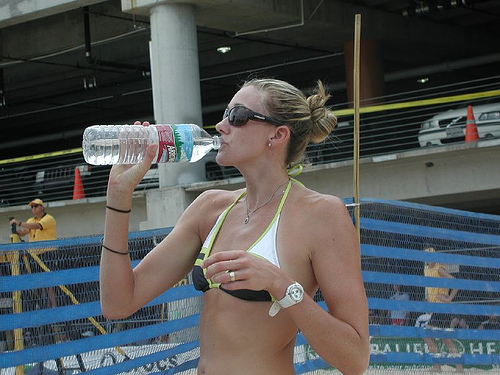Hydration Part 2: The Untold Story
Pay ATTENTION! These are tips that will not only help your volleyball game, but help your life too.
If you remember from the previous Hydration post, the quality of water that you put in your body is so important. That’s why I use a water filter like the very affordable Sparkling Spray 2 Shower Filter to keep as much chlorine and contaminated matter out of my body as possible.
Now as promised, let’s talk about how to maximize the ability of your cells to perform and recover during periods of intense exertion. If you’re looking for the best results, put the sport’s drink down. I won’t knock any brand names, but I’ve never seen a mass produced sport’s drink that will give you all benefit and no consequence at a reasonable price.
Here is a simple (wikipedia) composition of sweat: “Sweat contains mainly water. It also contains minerals, lactate, and urea. Mineral composition varies with the individual, their acclimatization to heat, exercise and sweating, the particular stress source (sauna, etc.), the duration of sweating, and the composition of minerals in the body.
An indication of the minerals content is sodium (0.9 gram/liter), potassium(0.2 g/l), calcium (0.015 g/l), magnesium (0.0013 g/l).[11] Also many other trace elements are excreted in sweat, again an indication of their concentration is (although measurements can vary fifteen fold) zinc (0.4 milligrams/liter), copper (0.3–0.8 mg/l), iron (1 mg/l), chromium (0.1 mg/l), nickel (0.05 mg/l), lead (0.05 mg/l).[12][13] Probably many other
less-abundant trace minerals leave the body through sweating with correspondingly lower concentrations.”
OK, so sweat is water, minerals, lactate (the byproduct of lactic acid produced when the cell burns glucose for energy) and urea which is byproduct of protein metabolism.
(An interesting note about protein metabolism in the Protein Series I wrote for the Body Blog.)
If you’re drinking regular water while you play, you are helping to restore the water lost but tap and bottled water are devoid of the minerals that are lost. You don’t need to worry about replacing lactate or urea as those are byproducts and toxins from metabolism. On to the minerals. Sports drinks often have calcium, magnesium and potassium added to them because sweat has the highest concentration of those 3 minerals. However, there are a lot of trace minerals lost in sweat too and when we don’t replace those, we can run into issues of cramping, exhaustion, and risk of injury.
Sodium is both under-utilized and over-utilized. Some people don’t use it at all when re-hydrating and some people use it too much in the case of salt tablets and pouring the carton of table salt in their mouth. Ask me how I know, and the answer is this: I’ve spent years trying to master cramping, dehydration and exhaustion while exercising.
I always worked out a ton and have had some of the best trainers in the world. My personal level of fitness has never been the issue. I have hyperhydrosis which is overactive sweat glands. I have been a chronic cramper and certainly prone to dehydration. It’s not been until the last 2 years that I’ve been able to make significant strides in my endurance and recovery ability thanks to a focus on my nutrition. If I can master cramping and dehydration (for the most part) with my condition, the vast majority of you out there should be able to thrive with these tips!
Minerals are often misunderstood, but I can tell you that they are the most important part of our body’s ability to perform, recover and repair. Minerals are necessary for nearly every body function. Just because sodium, calcium, magnesium and potassium are the most abundant doesn’t make the trace minerals any less important. As an example, we can’t walk upright without feet or big toes, but that doesn’t mean the increased balance that our smaller toes provide us is any less important.
Minerals also come in many forms. When we eat plants, they contain the natural compounds which help us to better absorb them. However, we’re athletes and we need the minerals now, not later, so we use supplements and drinks. When it comes to synthetic minerals, not all are created equal. Read about the different forms of minerals in this POST. There are high quality and low quality minerals that have different effects on our body’s ability to absorb them. Kind of like listening to the radio, if you’re just a little bit off the station, you can still hear what’s going on for the most part, but with a lot of background noise and distortion. When you have high-quality minerals, it’s like tuning into your favorite radio station and getting perfect reception to hear it loud and clear.
So what’s best? In my opinion, you need to make your own sport’s drink for optimal results. The good news? Often it’s cheaper than paying for one of those inferior name brands off the shelf. It may not have all the added sugar you’re used to, but that’s not a bad thing!
So as not to make this post too long, and to keep you reading more, I am going to give you my secret sport drink concoction in the next article. Also, there is a key nutrient that most of us are not getting enough of that will help your cells absorb water and nutrients faster than ever before. Straight down to business in the next article but for now, read up on your minerals and what they do. If you want a comprehensive approach to what different minerals and nutrients do inside your body, download my free e-book, The Winter Wellness Diet by clicking the link and signing up on the bottom right of the Body Blog home page.
***
Hydration Part I
By Russ Marchewka
As athletes, weekend warriors and bar hoppers we know it’s important. Hydration is more than just water, it’s about health too. I’ve studied health and the human body for almost 8 years now, and while I’ve got a really good foundation, there are so many complications with this machine we call our body.
Instead of boring you with too many details and intricacies, you’ll have to take my word for it when I say this is the tip of the iceberg. This rabbit hole goes pretty deep. So, what’s the first thing you think of when it comes to hydration? Water, right?
Our bodies are 3/4 water so we definitely need a lot of it. You’ve probably heard the rule of thumb, 8oz of water for every 10-15 minutes of activity. I know for volleyball players, especially beach players out in the sun you may want to look at doubling that. Consider the source and quality of the water that you’re drinking. I mean if water makes up 3/4 of our body by weight, then the quality of water is a huge deal!
Most municipal sources of tap water are chlorinated and fluoridated. They add chlorine to kill bacteria and fluoride to strengthen our teeth. Actually, there isn’t much, if any, credible evidence that adding fluoride to water decreases cavities. Fluoride is a poison when consumed in excess and think about how much water we use every day.
Actually, the “conspiracy theory” is (and it’s not so out there) that manufacturing companies were going to dump their fluoride byproducts into rivers and oceans to get rid of them. A group lobbied public health agencies about fluoride and dental health. So instead of throwing the fluoride away they sold it to water agencies and made a profit! If you do some internet research you’ll find I’m not wrong about this.
Did you know that when you take a hot shower the chemicals that are added to the water become vaporized and you breathe them in? Considering we absorb 3-5 times more of these chemicals when we breathe them in as opposed to drinking them.
Drinking them has its own problems though. The chlorine and fluoride can get into your intestines and end up killing a lot of the helpful, good bacteria. Good bacteria help to break down our food for better digestion and nutrient uptake. The less good bacteria we have the less effectively we can use our food for fuel and repair.
Additionally, our immune system is in our “gut” which is just another term for intestines. As athletes the last thing we want while in season or pre-season training is to get sick. To stay on top of our games we need to stay healthy so we can push our bodies to the limit every day. When these good bacteria die as a result of the chlorine and fluoride, our health is dramatically compromised. Our immune systems are not as strong and capable to fight off bacteria and viruses.
So maybe you’re thinking of boycotting the tap water now? Drinking bottled water has its own set of challenges. Virtually all bottled water is plastic bottles, and virtually all plastic bottles have Bisphenol-A (BPA), a chemical in the production process. Known as a phyto-estrogen, this chemical mimics estrogen hormones in our body, telling us to produce more. Throwing off our hormonal balance is nothing short of disastrous. Hormone imbalances are being heavily researched and found to be one of the top cancer causing agents. Man or woman, we both need estrogen. We both have a natural balance and BPA throws it off. Once again, search BPA dangers for more info.
Also, bottled water is terrible for the environment. Recent studies have discovered as many as 80% of all bottled water bottles end up in landfills instead of getting recycled.
So what to do? Well, I wouldn’t be writing this piece for you if I didn’t have some suggestions based on personal research and experience. So here’s what I do: If I’m at a tournament, I know I’ll need way more water than I can take with me so I just drink what is there and don’t stress about it. For practices and every day life however, that’s a different story. Since the majority of your day is outside the gym or off the beach, consider the following.
I did some research into water filtration technology and found the most effective filtration process for chlorine and other contaminants was this “KDF filtration” process. I then looked into filters with this technology. I found a bunch that installed into your kitchen faucet for a few hundred bucks. In this economy though, that was pretty steep. So I got creative!
I bought a KDF filter for my shower. Killing 2 birds with one stone. I get cleaner water while I am taking a shower so I don’t breathe in those toxic chemicals. Also, here’s where I got creative. I just take a big pitcher into the bathroom and fill it up from the shower for my cooking and drinking water.
Best of all, the filter is $30 and lasts for about 2 years. Way less expensive than the water filtering pitchers that are much less effective. I was amazed at how good I felt by drinking this cleaner water. Additionally, showers are exponentially more refreshing. No more itchy skin or burning eyes. I have softer hair and skin as a result which for volleyball players is a small luxury most thought we had to give up.
I’ll talk about the biological process of hydration next time with some things you can add to your water to increase the absorption rate while you play. That’s a pretty interesting conversation too!
For now, I’d be remiss if I didn’t give you a link to check out the Sparkling Spray 2 Shower Filter. This is the actual filter I use and have gotten great results with.
Who is Russ Marchewka?
Russ is a professional beach volleyball player and the 25th ranked player in the US. In his free time he writes and edits The Body Blog and just started the World Health Club, a store dedicated to selling high-quality health products from companies that are eco-friendly and care about the environment as much as you do.




5 Comments
Leave a Reply